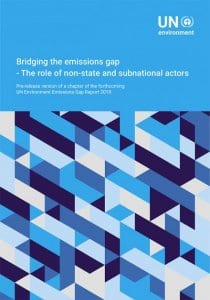Latest UN Reports on Climate

UN Environment Emissions Gap Report [November 2018]
- To achieve the goal of limiting climate change to 2°C, countries need to triple the level of their commitments made under the Paris Agreement.
- To achieve the goal of limiting climate change to 1.5°C, countries would have to increase their level of ambition by 5x.
- Global emissions have reached historic levels at 53.5 GtCO2e, after a three-year period of stabilization, with no signs of peaking.
- Only 57 countries (representing 60 percent of global emissions) are on track to meet their commitments by 2030.
- If the emissions gap is not closed by 2030, it is extremely unlikely that the 2°C temperature goal can still be reached.

World Meteorological Organization Greenhouse Gas Bulletin [November 2018]
- Globally, averaged concentrations of CO2 reached 405.5 parts per million (ppm) in 2017, up from 403.3 ppm in 2016 and 400.1 ppm in 2015.
- Concentrations of methane and nitrous oxide also rose, whilst there was a resurgence of a potent greenhouse gas and ozone depleting substance called CFC-11, which is regulated under an international agreement to protect the ozone layer.
- Since 1990, there has been a 41 per cent increase in total radiative forcing – the warming effect on the climate – by long-lived greenhouse gases. CO2 accounts for about 82 per cent of the increase in radiative forcing over the past decade, according to figures from the US National Oceanic and Atmospheric Administration.
- The last time the Earth experienced a comparable concentration of CO2 was 3-5 million years ago, when the temperature was 2-3°C warmer and sea level was 10-20 meters higher.

Intergovernmental Panel on Climate Change Special Report on Global Warming of 1.5°C [October 2018]
- The report highlights a number of climate change impacts that could be avoided by limiting global warming to 1.5ºC compared to 2ºC, or more.
- By 2100, global sea level rise would be 10 cm lower with global warming of 1.5°C compared with 2°C.
- The likelihood of an Arctic Ocean free of sea ice in summer would be once per century with global warming of 1.5°C, compared with at least once per decade with 2°C.
- Coral reefs would decline by 70-90 percent with global warming of 1.5°C, whereas virtually all (> 99 percent) would be lost with 2ºC.
- We have the tools we need to address climate change: the world doesn’t have to come up with some magic machines to curb climate change – the technology is available to take necessary climate action.
- Rapid changes must take place in four key parts of society: energy generation, land use, cities and industry.
